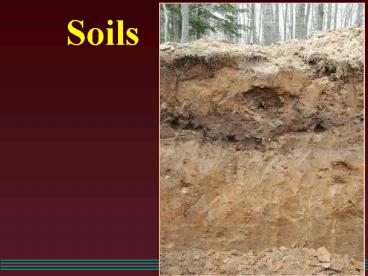Soils - PowerPoint PPT Presentation
1 / 18
Title: Soils
1
Soils
2
Soil Profiles
- General soil profile
- Letters represent horizons
- Numbers are layers within those horizons
- Code
- 0 litter
- A area of leaching and organic matter
accumulation - B area of accumulation
- C parent material
- R bedrock
See Text, Fig. 2.8
3
(No Transcript)
4
Soil formation
- Five main groups of soil forming factors
- climate (present as well as past
- vegetation (influenced by climate and soil fauna)
- parent material
- type of relief
- time
5
Mor (coniferous) typical profile
- Prominent organic deposit resting on the mineral
soil - Sharp distinction between 0 and A horizons
- Fungi are the main decomposers
- Small biomass of soil animals
6
Mull (broadleaf) typical profile
- Bacteria are the chief decomposers
- Soil animals more diverse gt humification
- More mixed upper horizons
- Animal activity also affects the soil porosity
7
0
Gradual change
Mor soil
Mull soil
8
Components of soil
- Sand (gravel consists of elements over 2 mm)
Silt (.05 - .002 mm)
Clay (less than .002 mm)
Humus (organic)
9
Litter build up
- Climate effects the amount of litter and humus
found in an ecosystem.
10
Organic Matter in Soil
- Benefits of Organic Matter
- Improves aggregation and structure
- Improves infiltration
- Improves water holding capacity
- Improves rooting environment
- Slow-release nutrients
11
Spaces for Gas and Water
- Particle size effects spaces for gases and water.
- Water movement is dependent on the spaces
12
- Adhesion and cohesive forces
- This is called capillary water
13
Water movement in different soils
Distance from center of furrow
Sandy Loam
Clay Loam
14
- Field capacity vs. gravitational water
- Hygroscopic water vs. available water
15
Soil Components
16
Nutrient exchange
- Negative charges on clay micelles, humus
particles and to a lesser extent on silt
particles - Cations (K,Ca, Mg, etc.) are attracted to
the negative charges
K
Ca
Ca
Ca
K
K
Ca
Ca
K
17
- Differences in sand, silt, clay, humus
- Size and charge of ion vs. tenacity with which it
is held - Order of tenacity with which the cations are
held - H gt Ca gt Mg gt K gt Na
18
(No Transcript)































